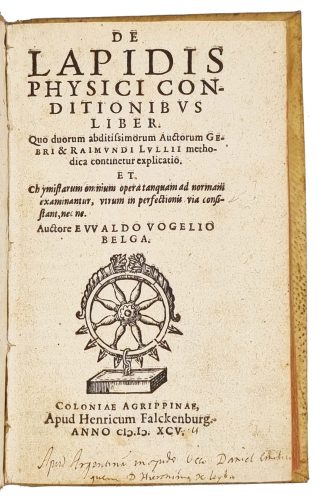HOGELANDE, Theobaldus van; VOGEL, Ewald.
THE PHILOSOPHER’S STONE
De Lapidis Physici conditionibus liber.
Cologne, H. Falckenburg, 1595.£4,500.00
FIRST EDITION. 8vo. pp. [36], 252, lacking final blanks. Roman letter. Woodcut title vignette, decorated initials and ornaments. Slight browning, tiny worm hole turning into trail in lower part of initial gatherings (affecting a couple of letters on three or four ll.). A good copy in contemporary vellum over boards, title inked to spine, all edges sprinkled red, two small leather holes to upper cover, worm trail to lower joint, contemporary ms ‘Apud Argentina[m] in opido Occo(?) Daniel Emiliu(s?) quem D Hieronimus de Leyva’ at foot of title.
A good copy of the first edition of this scarce work on the nature and preparation of the Philosopher’s Stone (elixir), based on the works of Geber and Raymund Llull. Ferguson provides a long account of theories concerning authorship, some scholars suggesting that Vogel, calling himself ‘Belga’ in the title, and Hogelande were the same person, with either name a pseudonym for the real person. ‘De lapidis’ is based on iatrochemical theories, i.e., the interpretation and study of medicine and physiology in chemical terms; the purpose of the work is the production of the best elixir for longevity. The preface lists the 7 properties the Stone has to have to be useful in medicine: oiliness, fineness, affinity, radical humidity, purity, ‘terra figens’ and tincture. One chapter is devoted to each. The first explains how it is key to prepare the correct solution to start, using aquaforte, and studies the oiliness (i.e., ‘interna unctuositas’) of metals, how they tolerate fire, the definition and properties of oil, and procedures to prepare oil. The second, on ‘tenuitas’, discusses the ways in which bodies and spirits can be dissolved or ‘attenuated’ (e.g., gold and silver cannot be dissolved with mercury) and related alchemical procedures (distillation, calcination, sublimation), including errors that may be made. The third discusses the affinity and propinquity of the elixir in relation to the substance that is being transmuted, as well as the principles of transmutation, how alchemy imitates life and the corruption of metals. The fourth, on ‘radicalis humiditas’, explains how the three humours (primigenius/radicalis, nutritus, elementaris) can also be found in metals, how to extract the ‘humor radicalis’, its composition, and the poisonous qualities of mercury. The fifth, on ‘puritatis claritas’, discusses the purification of impure metals and sublimation; the sixth, on ‘terra fingens’, focuses on earth, the third element of the Stone; and the seventh, on ‘tinctura’, explains the tincture that provides the ‘splendid and perfect white colour’, how to obtain it and how only gold and silver can generate the elixir. A very dense, scarce and interesting alchemical work.
Hieronymus de Leyva (fl. C16) was a canonist, ‘vicarius generalis’ of Seville, and an ecclesiastical judge mentioned in print for dealing with controversies involving the Jesuits.
USTC 628680; VD16 V2071; Ferguson, Bib. chemica, II, p.514. Not in Durling, Duveen, Caillet or Wellcome.In stock




